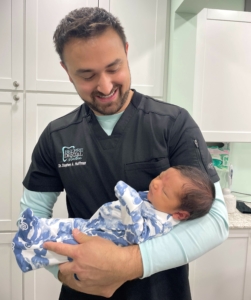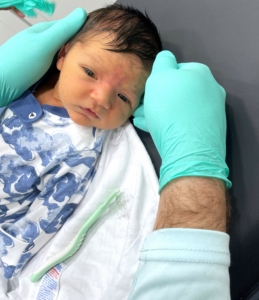Tongue & Lip Ties
We excel in treating tongue, lip, and cheek ties in infants, toddlers, and adult patients.
What are tongue & lip ties?
We often think “tongue-tied” means you can’t find the right word you want to say. However, truly being tongue-tied is a congenital condition where the thin membrane under the tongue (the lingual frenulum) is too short, too tight, or both and restricts the movement of the tongue to some degree. Basically, the tongue is tethered. For babies, tongue ties affect their ability to move their tongues freely and thus can affect their ability to latch and breastfeed properly. It can also lead to nipple pain and decreased milk supply overtime for the mother.
Many babies with a tongue tie, also have other ties. A lip tie is an abnormally tight membrane attaching the upper lip to the upper gums. Babies with a lip tie often have trouble flanging their lips to feed and can’t create a proper seal at the breast. This can cause them to take in excess air during breastfeeding, which often makes these babies gassy and fussy. Occasionally, cheeks may have frenulums and sometimes these are too short, or tight, or attached to the gumline in a wrong spot. Altogether, lip, tongue, and cheek ties are referred to as Tethered Oral Tissues or TOTS.
Signs and Symptoms of Tongue and Lip Ties
*Please keep in mind that each case is different, and all symptoms will likely not be present. We see many combinations of symptoms in patients.
Infants & Mothers
Some babies with tongue ties and lip ties are able to attach to the breast or bottle and feed properly, but many of these infants struggle while feeding. For infants and their mothers in cases of a tie, the following signs and symptoms are common.
Infant Symptoms:
- Noisy suckling
- Popping on and off the breast
- Leaking at corners of mouth
- Difficulty holding a pacifier
- Difficulty latching on nipple or bottle
- Lip curling under when feeding
- Poor weight gain
- Coughing or gagging
- Hiccups or burps often
- Lip blisters
- Gas pain
- Noisy breathing/snoring sounds when sleeping
- Reflux or colic symptoms
Mother Symptoms:
- Flattened nipples after breastfeeding
- Nipple pain, bleeding, and damage
- Prolonged feedings
- Poor breast drainage
- Decreased milk production
- Plugged milk ducts, engorgement, or mastitis
Toddlers & Children
If not addressed during infancy, tongue and lip ties will not resolve themselves, though the symptoms and signs are different.
- Speech difficult to understand
- Trouble with certain sounds
- Speech delay
- Stuttering
- “Baby talk”
- Mumbling or speaking softly
- Difficulty transitioning to solid foods
- Packing food in cheeks like a chipmunk
- Choking or gagging on food
- Slow eater (doesn’t finish meals)
- Sleeps in strange positions
- Kicks and flails around at night
- Wakes easily or often
- Wets the bed
- Wakes up tired and not refreshed
- Grinds teeth while sleeping
- Sleeps with mouth open
- Snores or gasps for air while sleeping
Toddlers and children may experience other related issues such as the following.
- Mouth breathing
- Strong gag reflex
- ADHD/ADD
- Constipation
- Thrush
- Headaches or migraines
- TMJ pain, clicking or popping
- Reflux
- Ear tubes previously
- Tonsils or adenoids removed previously
- Excessive gas or burping
- Orthodontic issues
Adults & Teenagers
As we grow and develop, our tongue and lip anatomy does not change and thus ties are not a condition we can “grow out of”. With that being said, the symptoms and signs do present somewhat differently for adults and teenagers.
- Sleeps in strange positions
- Kicks and flails around at night
- Wakes easily or often
- Wakes up tired and not refreshed
- Grinds or clenches teeth while sleeping
- Sleeps with mouth open
- Snores
- Gasps for air or stops breathing (sleep apnea)
- Has had a sleep study
- Uses a CPAP
- History of Orthodontics/ dental braces
- Neck or shoulder pain or tension
- TMJ pain, clicking, or popping
- Headaches or migraines
- Strong gag reflex
- Mouth open/Mouth breathing during day
- Bad breath
- Tonsils or adenoids removed previously
- Ear tubes previously
- Reflux (medicated or not)
- ADHD/ADD
- Constipation
- Speech issues
- Excessive gas or burping
- Difficulty kissing
How are tongue and lip ties diagnosed?
Tongue and lip ties are diagnosed through a simple visual and manual examination of the oral tissues by Dr. Stephen A. Huffman or another provider that has received this highly-specialized training on TOTS. Tongue, lip, and cheek ties are diagnosed based upon function, meaning what they look like can sometimes be less important than how they can move.
Treatment for Ties
The treatment for a tie is called frenotomy or frenectomy. Dr. Huffman uses a state-of-the-art laser for a safe, precise, and quick release (usually 1 minute or less per tie). This minor surgery releases the frenulums allowing the muscles of the tongue, lip or cheek to move more freely. The use of a laser rather than a scalpel or scissors minimizes the bleeding and allows for clear visibility so the tie can be 100% released. Numbing is provided as appropriate to keep patients comfortable through the procedure.
Treating tongue and lip ties can empower those who really want to breastfeed but are experiencing difficulties. These treatments can also significantly benefit bottle-fed babies. By addressing tongue, lip and buccal ties, bottle-fed babies can improve their ability to latch onto the bottle more effectively, reducing feeding time and minimizing discomfort. Additionally, this can help prevent issues such as gas and reflux, ensuring a more comfortable and satisfying feeding experience for bottle-fed infants as well.
After-Care
The recovery is relatively quick and easy with follow-up massages of the tissue to ensure ties do not reconnect. For infants, mothers will be able to nurse their babies right after the release procedure. Many mothers do notice an immediate difference in the way their baby feeds. We provide patients with clear post-operative instructions for the surgical site massages and pain and soreness management along with a referral for post-operative bodywork with one of our community partners. We are also available to answer follow-up patient / parent questions and provide on-going support.
About the Provider
As a baby-lover, father of two and uncle to 24, Dr. Huffman feels strongly about relieving the unnecessary suffering caused by TOTS. When his first son was born, a lactation consultant at the hospital approached Dr. Huffman as a dentist and made him aware that treatment for tongue and lip ties was not locally available in the Mid-Ohio Valley. She encouraged him to seek the specialized training to treat this problem that can have a very negative impact on quality of life for the young and old. Dr. Huffman’s training included one-on-one instruction with Dr. Greg Notestine, founding member of the International Affiliation of Tongue-tie Professionals or IATP and national leader in TOTS treatment. He is very passionate about providing state-of-the-art treatment to our community and is a proud member of the International Consortium of Ankylofrenula Professionals or ICAP.

Pictured: Dr. Stephen A. Huffman & Dr. Greg Notestine, Founder of IATP
“It is very important to me that mothers and infants in the Mid-Ohio Valley have the medical support they need for diagnosing and treating tongue and lip ties and the many challenges they can create. Our ultimate goal with this treatment is to improve the quality of life of our patients, both children and adults.”
-Dr. Stephen A. Huffman
Are you or your child suffering with a lip or tongue tie?
Up to 10% of all newborns are born with a tongue tie.
*According to the Mayo Clinic
Learn more about what we offer:
Tethered Oral Tissues (TOTS) FAQs
Tongue & Lip Tie Gallery
New Patients
Pediatric Dental Care








